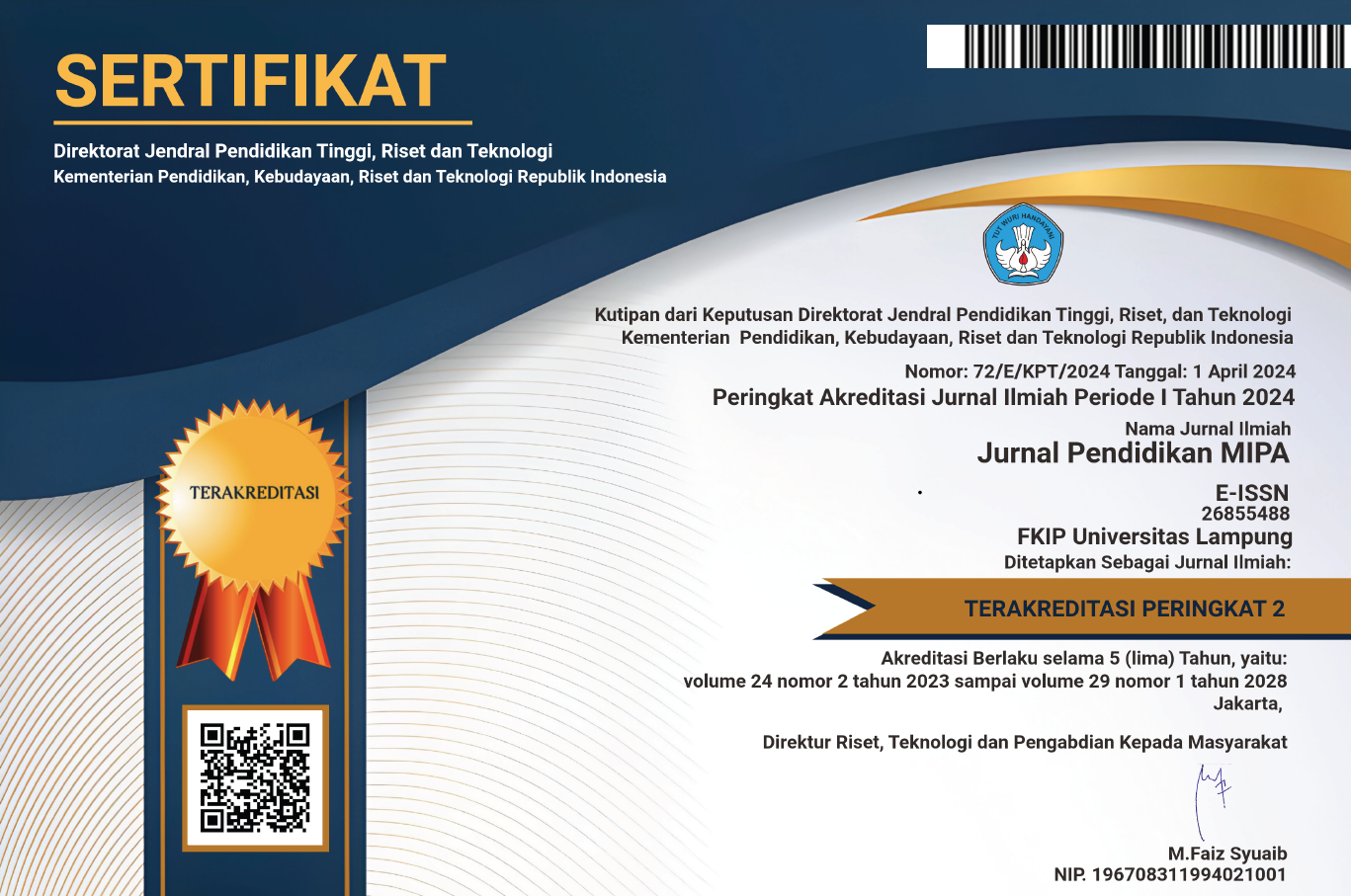Using Cellphone in Problem-Based Biology Learning to Improve Students’ Creative Thinking Skills
 Country:
Country:
(1) Universitas Negeri Padang, Indonesia
(2) Universitas Negeri Padang, Indonesia
Students' creative thinking skills need to be developed in the learning process. However, the learning process in schools has not fully implemented learning models that develop students' skills. From the results of observations at SMAN 7 Padang, learning at school still does not make use of Information and Communication Technology (ICT) and lacks interest in learning in class. To overcome these problems, the Problem Based Learning (PBL) model which is intervened with the use of ICT is applied. The use of ICT used is utilizing cellphone and internet networks in obtaining broader information. This study aims to analyze the effect of the implementation of the problem-based learning model that is intervened by information technology on students' creative thinking skills. This type of research is quasi-experimental research with a randomized control-group posttest only design. The results of testing the hypothesis, namely tcount > ttable, indicate that the research hypothesis is accepted.
Keywords: problem-based learning, information and communication technology, creative thinking skills, cellphone.
Amri, A., & Muhajir, H. (2022). Keterampilan berpikir kreatif peserta didik melalui model project based learning (PJBL) secara daring. Didaktika Biologi: Jurnal Penelitian Pendidikan Biologi, 6(1), 21-29.
Asyari, M., Al Muhdhar, M. H. I., & Susilo, H. (2016). Improving critical thinking skills through the integration of problem-based learning and group investigation. International Journal for Lesson and Learning Studies.
Aziz, S. A. (2012). Pengembangan kemampuan berpikir kreatif siswa dalam pembelajaran matematika dengan pendekatan pendidikan matematika realistik Indonesia (PMRI). Yogyakarta: AL Badiyah.
Bereczki, E. O., & Kárpáti, A. (2021). Technology-enhanced creativity: A multiple case study of digital technology-integration expert teachers’ beliefs and practices. Thinking Skills and Creativity, 39, 100791.
Buckingham Shum, S., & Crick, R. D. (2016). Learning analytics for 21st century competencies. Journal of Learning Analytics, 3(2), 6-21.
Darimi, I. (2017). Information and communication technologies sebagai media pembelajaran pendidikan agama Islam efektif era teknologi informasi. Cyberspace: Jurnal Pendidikan Teknologi Informasi, 1(2), 111-121.
González-Salamanca, J. C., Agudelo, O. L., & Salinas, J. (2020). Key competences, education for sustainable development and strategies for the development of 21st century skills. A systematic literature review. Sustainability, 12(24), 10366.
Huang, B., Hwang, G. J., Hew, K. F., & Warning, P. (2019). Effects of gamification on students’ online interactive patterns and peer-feedback. Distance Education, 40(3), 350-379.
Iswan, I., & Bahar, H. (2018, July). Penguatan pendidikan karakter perspektif Islam dalam era millenial IR 4.0. In Prosiding Seminar Nasional Pendidikan (Vol. 1, No. 1).
Jin, J., & Bridges, S. M. (2014). Educational technologies in problem-based learning in health sciences education: a systematic review. Journal of Medical Internet Research, 16(12), e3240.
Kemendikbud. (2018). Modul pelatihan implementasi kurikulum 2013. Badan Pengembangan Sumber Daya Manusia Pendidikan dan Budaya dan Penjamin Mutu Pendidikan.
Kemendikbud. (2016). Panduan penilaian oleh pendidik dan satuan pendidikan untuk SMA. Direktorat Pembinaan SMA.
Kuhlthau, C. C., Maniotes, L. K., & Caspari, A. K. (2015). Guided inquiry: Learning in the 21st century. ABC-CLIO.
Kumar, V., & Nayak, J. K. (2018). Destination personality: Scale development and validation. Journal of Hospitality & Tourism Research, 42(1), 3-25.
McGibbon, C., & Van Belle, J. P. (2015). Integrating environmental sustainability issues into the curriculum through problem-based and project-based learning: a case study at the University of Cape Town. Current Opinion in Environmental Sustainability, 16, 81-88.
Merrill, J. (2014). Increasing creativity in design education: measuring the effect of kognitiva on student creativity. Kansas: State University Manhattan.
Mukninan, M. (2012). Peran ICT dalam pembelajaran. Makalah disajikan dan dibahas pada seminar nasional teknologi pendidikan. Surabaya: Universitas PGRI Adibuwana.
Munandar, U. (2012). Pengembangan Kreativitas Anak Berbakat. Jakarta: Rineka Cipta.
Palincsar, A. S., & Schleppegrell, M. J. (2014). Focusing on language and meaning while learning with text. TESOL Quarterly, 48(3), 616-623.
Samerkhanova, E. K., Krupoderova, E. P., Krupoderova, K. R., Bahtiyarova, L. N., & Ponachugin, A. V. (2016). Students' network project activities in the context of the information educational medium of higher education institution. International Journal of Environmental and Science Education, 11(11), 4578-4586.
Wardani, R. (2018). 21st Century Educator: Menyongsong transformasi pendidikan 4.0. In Slide Seminar Nasional Dinamika Informatika Senadi UPY.
Yeh, Y. C. (2010). Integrating collaborative PBL with blended learning to explore preservice teachers’ development of online learning communities. Teaching and Teacher Education, 26(8), 1630-1640.
Yerimadesi, Y., Warlinda, Y. A., Hardeli, H., & Andromeda, A. (2022). Implementation of guided discovery learning model with sets approach assisted by chemistry e-module to improve creative thinking skills of students. Jurnal Penelitian Pendidikan IPA, 8(3), 1151-1157.
Yokhebed, S., & Sunarno, W. (2012). Pembelajaran biologi menggunakan model pembelajaran berbasis masalah dengan pendekatan keterampilan berbasis proses sains untuk meningkatkan motivasi belajar dan hasil belajar. Jurnal Inkuiri, 1(3).
Refbacks
- There are currently no refbacks.

This work is licensed under a Creative Commons Attribution-ShareAlike 4.0 International License.






